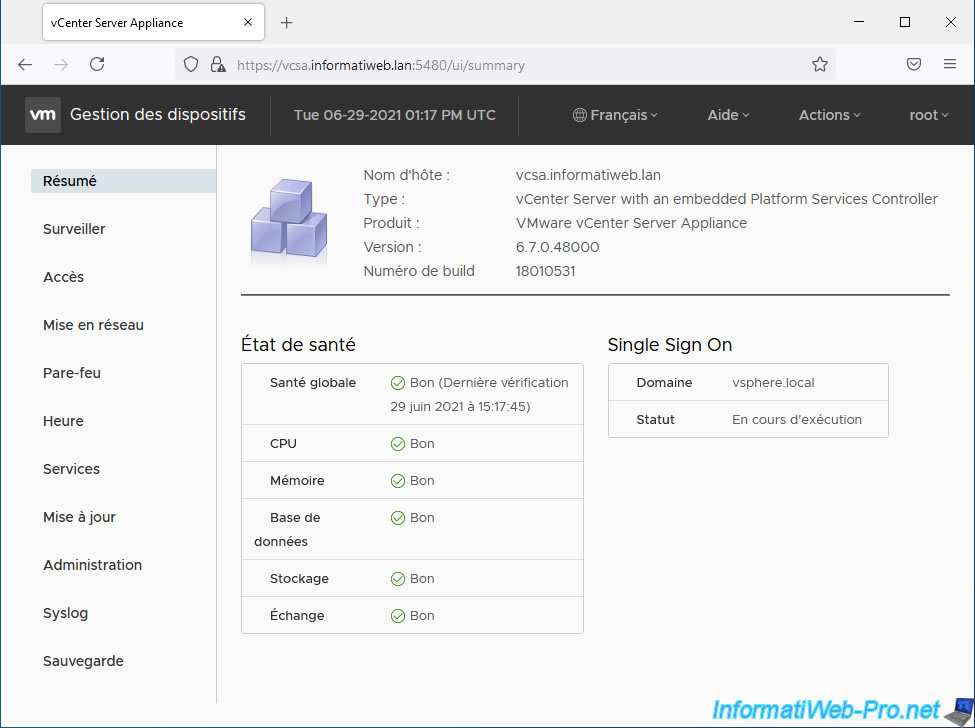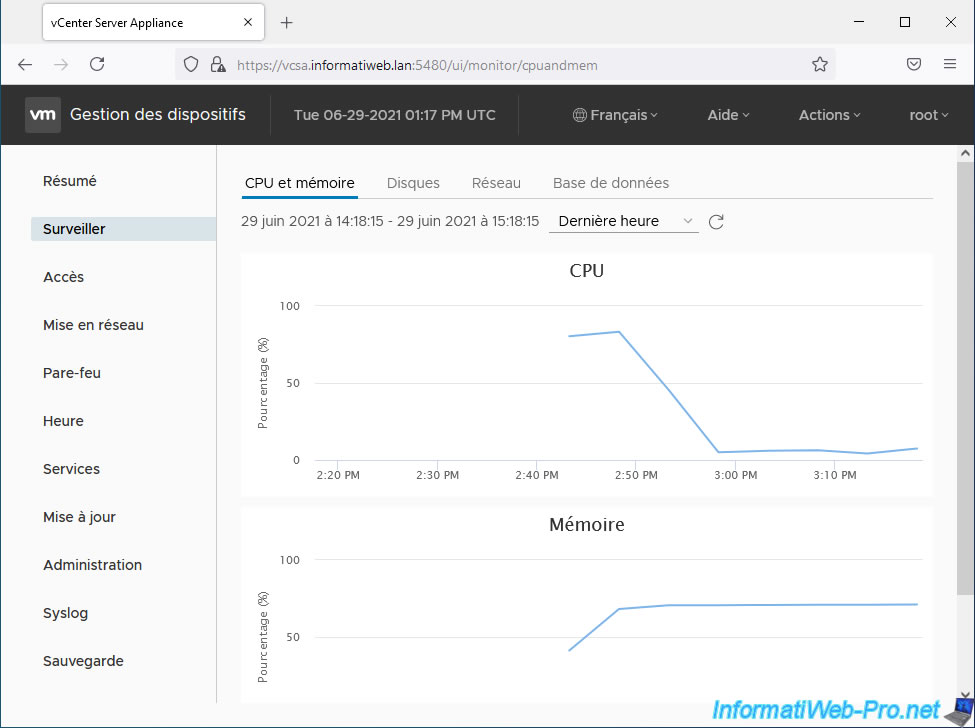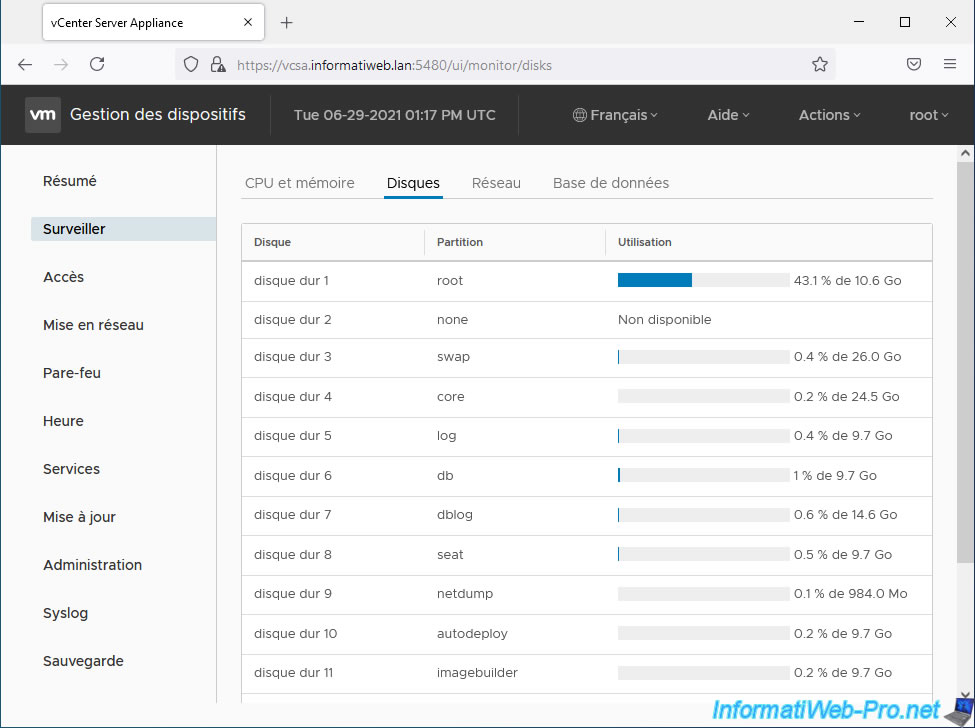Create a VMware vSphere 6.7 infrastructure by deploying VCSA (vCenter Server Appliance)
- VMware
- VMware vCenter Server (VCSA), VMware vSphere
- 21 February 2024 at 09:18 UTC
-

- 3/3
7. Overview of the VCSA appliance management interface
7.1. Overview of the appliance management interface
In the "Summary" section you will find:
- the host name: vcsa.informatiweb.lan
- the type of deployment performed: vCenter Server with an embedded Platform Services Controller
- the VMware product used: VMware vCenter Server Appliance
- the version of this one: 6.7.0.48000
- its build number: 18010531
You will also find his state of health with the overall state of health, as well as that of:
- CPU: its processor
- Memory: its random access memory (RAM)
- Database: its integrated PostgresSQL database (default)
- Storage: its storage (hard drive)
- Swap: its swap files
For the "Single Sign-On" block, you will find the name of the vCenter Server Single Sign On (SSO) domain used.
Default: vsphere.local.

In the "Monitor" section, you will be able to monitor the performance of your VCSA device by analyzing resource usage at the CPU (processor) and RAM (random access memory) level.

In the "Disks" tab of this "Monitor" section, you can also monitor the usage rate of the different disks of this VCSA device.

In the "Network" tab you will be able to see if any errors are occurring at the network level, as well as possible packet losses, ...

In the "Database" tab, you will be able to monitor the usage of the built-in PostgresSQL database used by VCSA.

In the "Access" section, you can:
- SSH Login: whether to allow remote command line access via SSH to this VCSA appliance.
- DCLI: enable or disable the DCLI (Datacenter Command-Line Interface) which allows you to interact with a VMware vCenter Server and which works exclusively with vSphere Automation API (REST API for vSphere).
- Console CLI: allows you to use the command line from the console of your VCSA virtual machine.
- Bash Shell: allows you to enable the Bash shell for other users. In fact, this is already activated for the root account by default.
You will notice that the French translation of this parameter is not very meaningful.

In the "Networking" section, you can find out the network configuration of your VCSA device:
- Hostname: its host name.
- DNS Servers: the DNS server(s) it uses.
- NIC 0 - Status: status of the network card of this one. Active or not.
- NIC 0 - MAC Address: its MAC address (which necessarily begins with "00:0C:29" like any VMware virtual machine).
- NIC 0 - IPv4 Address: its IPv4 address, its CIDR (which varies depending on the subnet mask used) and whether it was defined statically or received dynamically.
- NIC 0 - IPv4 Default Gateway: IPv4 address of the gateway used by it.
For the "Proxy Settings" part, this allows you to redirect HTTPS, HTTP and FTP traffic through a proxy server.
Which is very practical in business, because Internet access is often limited or secure.

In the "Firewall" section, you will be able to add, modify or delete rules for it.

In the "Time" section you will find:
- Time zone: the time zone used by your VCSA device. Default: Etc/UTC.
- Time synchronization: time can be synchronized from the VMware ESXi host or from an NTP server.
- Current appliance time: the current time of your VCSA device.

In the "Services" section, you will find the list of services present on this VCSA device.

In the "Update" section, you will be able to see:
- Appliance Type: the type of deployment used. In our case: vCenter Server with an embedded Platform Services Controller.
- Version: the version of the VCSA device.
- Available updates: the list of updates available for your VCSA appliance.

In the "Administration" section, you can:
- Password: change the root account password of your VCSA device
- Password expires: specifies whether or not the password should expire automatically.
- Password validity (days): indicates after how long the password will expire (if automatic password expiration is enabled)
- Email for expiration warning: allows you to set the email address to which your VCSA appliance will automatically send a reminder email before the password expires
- Password expires on: find out when this password will expire.

In the "Syslog" section, you can configure the transfer of logs to a remote Syslog server, if you wish.
This can be practical for centralizing the logs of your different VMware components on the same Syslog server, as well as being able to access them, even if the server concerned (VCSA in this case) is no longer starting.

Finally, in the "Backup" section, you can schedule the automatic backup of your VCSA device to a backup server.

7.2. Actions menu
Thanks to the "Actions" menu, you can:
- reboot your VCSA appliance
- shut down your VCSA appliance
- create a support bundle to send to VMware support in the event of a problem with your VCSA appliance

If you click "Create Support Bundle", you will get a compressed file with a name similar to this: vc-vcsa.informatiweb.lan-2021-06-29--13.19-30175.tgz.

7.3. Change the time zone used by VCSA
By default, the time zone used by your VCSA device is "Etc/UTC".
To change it, go to the "Time" section and click on the "Edit" link in the "Time zone" section.

From the list of time zones that appear, select the one corresponding to your country.
For example :
- US/Alaska
- America/New_York

The time zone has changed.

7.4. Disconnect from VCSA appliance
To log out of your VCSA appliance, click: root -> Logout.

Share this tutorial
To see also
-

VMware 5/15/2024
VMware vSphere 6.7 - Add a physical disk to host
-

VMware 8/21/2024
VMware vSphere 6.7 - Add a VMkernel interface
-

VMware 10/9/2024
VMware vSphere 6.7 - Clone virtual machines to a content library
-

VMware 1/24/2025
VMware vSphere 6.7 - Create a network protocol profile

No comment